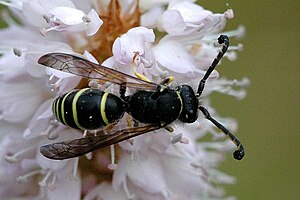Common chimney wasp
| Common chimney wasp | ||||||||||||
|---|---|---|---|---|---|---|---|---|---|---|---|---|

Common chimney wasp ( Odynerus spinipes ) |
||||||||||||
| Systematics | ||||||||||||
|
||||||||||||
| Scientific name | ||||||||||||
| Odynerus spinipes | ||||||||||||
| ( Linnaeus , 1758) |
The Common chimney wasp ( Odynerus spinipes ) is a Hymenoptera from the family of wasps (Vespidae). The species is endangered.
features
The slim type reaches a body length of 10 to 13 millimeters. Her black abdomen wears narrow and straight yellow bands. The back label is black. The males can be recognized by their antennae tips, which are rolled up into spirals . The species can be confused with several species of its genus. It differs from the yellow chimney wasp ( Oplomerus reniformis ) by the less pronounced yellow color of the body. In addition, the males of the similar species have thorns on the hip joints of the middle pairs of legs and on the cheeks behind the mandibles .
Occurrence
The common chimney wasp is widespread in Central Europe and is common almost everywhere. They can be found on cliffs containing clay and loess, such as in sand pits, on the banks of waters or on ravines. It seldom nests on horizontal soil without vegetation. It flies from May to July.
Way of life
The females usually build their nests on steep walls and dig a passage diagonally downwards. They bring in water to mix the excavated material with it so that it can then be attached in a ring around the entrance. This creates a tube that is initially horizontal and later curved straight down. When the nests are laid horizontally on the floor, it points upwards at an angle. The individual clay parts are not neatly joined together, so that the tube appears to be broken in places. It can be up to five centimeters long and about one centimeter in diameter. This construction is unique within the genus, so that the species can be easily identified. The nest inside the ground has an elongated chamber at the end in which a stalked egg is placed on the ceiling. The food for the larva is then introduced into the chamber . These are exclusively weevil larvae of the genus Phytonomus , of which about 20 are collected. Subsequently, further chambers branching off from the main course are created, in each of which an egg is laid. Finally, the entrance to the nest is closed again using the material from the porch that was previously created.
swell
literature
- Heiko Bellmann : bees, wasps, ants. Hymenoptera of Central Europe . Franckh-Kosmos Verlags-GmbH & Co KG, Stuttgart 1995, ISBN 3-440-09690-4 .